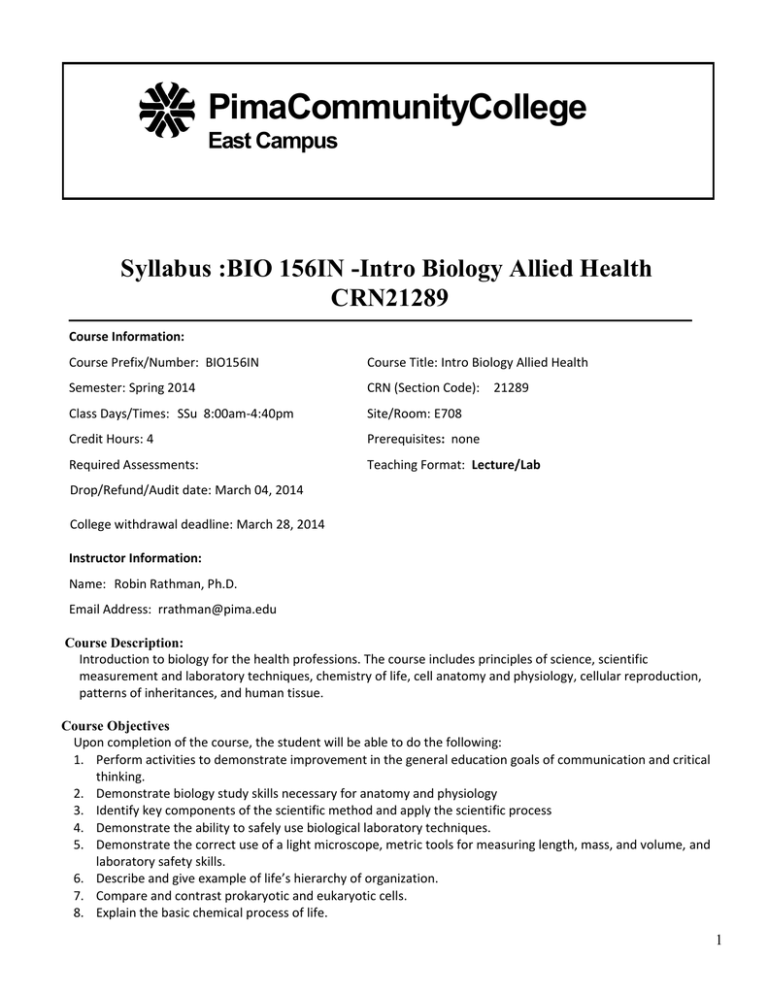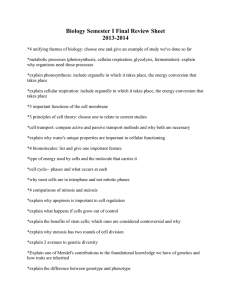PimaCommunityCollege Syllabus :BIO 156IN -Intro Biology Allied Health CRN21289
advertisement

PimaCommunityCollege East Campus Syllabus :BIO 156IN -Intro Biology Allied Health CRN21289 Course Information: Course Prefix/Number: BIO156IN Course Title: Intro Biology Allied Health Semester: Spring 2014 CRN (Section Code): 21289 Class Days/Times: SSu 8:00am-4:40pm Site/Room: E708 Credit Hours: 4 Prerequisites: none Required Assessments: Teaching Format: Lecture/Lab Drop/Refund/Audit date: March 04, 2014 College withdrawal deadline: March 28, 2014 Instructor Information: Name: Robin Rathman, Ph.D. Email Address: rrathman@pima.edu Course Description: Introduction to biology for the health professions. The course includes principles of science, scientific measurement and laboratory techniques, chemistry of life, cell anatomy and physiology, cellular reproduction, patterns of inheritances, and human tissue. Course Objectives Upon completion of the course, the student will be able to do the following: 1. Perform activities to demonstrate improvement in the general education goals of communication and critical thinking. 2. Demonstrate biology study skills necessary for anatomy and physiology 3. Identify key components of the scientific method and apply the scientific process 4. Demonstrate the ability to safely use biological laboratory techniques. 5. Demonstrate the correct use of a light microscope, metric tools for measuring length, mass, and volume, and laboratory safety skills. 6. Describe and give example of life’s hierarchy of organization. 7. Compare and contrast prokaryotic and eukaryotic cells. 8. Explain the basic chemical process of life. 1 9. Describe the four categories of “macromolecules” and why each is important for cellular structure and functions. 10. Explain how enzyme functions. 11. Describe the structure of cellular organelles and how each functions. 12. Describe specifically membrane transport mechanisms, protein synthesis and packing, and anaerobic and aerobic cellular respiration. 13. Describe the cell cycle and the purposes, products, and processes of mitosis and meiosis. 14. Explain how genes are expressed and inherited, and the molecular biology of gene expression. 15. Describe the principles of Mendelian Genetics. 16. Describe and give examples of the primary human tissues, and where in the body each can be found Course Outline: 1. Principles of Science A. Scientific process and scientific experimentation B. Analyzing and reporting results 2. Scientific Measurement and Laboratory Techniques A. Light microscopy B. Metric measurements 3. Introduction to Biology A. Levels of organization (life’s hierarchy) B. Cellular diversity (prokaryotic vs. eukaryotic cells) 4. Chemistry of Life A. Basic general chemistry B. Macromolecules i. Carbohydrates ii. Lipids iii. Proteins iv. Nucleic Acids C. Enzymes and energy D. Metabolism 5. Cell Anatomy and Physiology A. Cell membrane and transport mechanisms B. Organelle structure and function i. Nucleus ii. Ribosomes and protein synthesis (transcription and translation) iii. Endomembrane system iv. Mitochondria and cellular respiration v. Cytoskeleton 6. Cellular Reproduction A. Cell cycle B. DNA replication C. Mitosis D. Meiosis 7. Patterns of Inheritances A. Molecular biology B. Mendelian genetics 8. Human Tissues A. Epithelium B. Connective tissue C. Muscular tissue D. Nerve tissue 2 Textbooks/Instructional Materials: Human Anatomy & Physiology 9th Edition by Marieb &Hoehn Lab Manual: Laboratory Manual, East Campus ADA Compliance: Pima Community College provides reasonable academic accommodations to those students who qualify under the Americans with Disability Act (ADA). Appropriate documentation will be required to determine eligibility to receive accommodations. If you need an accommodation to participate in this class, please contact the campus Disabled Students Resource (DSR) office at 206 – 6688 to begin the accommodation request process. Academic Integrity: Students are expected to abide by the Student Code of Conduct http://www.pima.edu/studentserv/studentcode/index.shtml and the Code of Academic Integrity, http://www.pima.edu/studentserv/studentcode/studentcode-2-conduct.shtml ( also available at PCC campus libraries). Pima Community College considers violations scholastic ethics, plagiarism, as serious offence, which may result in failure of an assignment, the course, or possible expulsion. All work done for the class must be your own, unless it is instructed for group activities. For assignments, you may use work from books and other materials if properly cited. Attendance: Attendance, preparation, and participation in the class are important. Excessive absence of 2 or more will be a drop of one letter grade. Any more absence past 4 will constitute another lowering by another full letter grade. Arriving one hour late or leaving one hour early will be considered an absence from the class. Classroom Behavior: Refer to the Student Code of Conduct http://www.pima.edu/studentserv/studentcode/index.shtml for requirements relating to student behavior. Because of insurance limitations, non-registered visitors are not allowed at class sessions or on field trips. Possession of drugs, alcohol or firearms on college property is illegal. Eating, drinking, smoking and soliciting are not allowed in classrooms. Pets, telephones, pagers and other electronic devices that distract students are not allowed in classrooms. Students creating disturbances that interfere with the conduct of the class or the learning of others, violations of the Student Code of Conduct, will be referred to the Division Dean and/or the Dean of Students. Disruptive behavior will not be tolerated and can be cause for being dropped from the class. Disruptive behavior is defined as behavior that is disruptive to the learning process and outside normal behavior parameters. See the Student Code of Conduct for particulars, but examples of disruptive behavior are inappropriate talking, arriving late or leaving early, sleeping or doing other class work in class, etc. 3 Grading Procedures and Policy: There will be 3 multiple choice exams, 13 written assignments, 13 lab activities and 3 quizzes that all count a total of 300 pts. The exams will count 25 pts each, written assignments count 5 pts each, lab activities count 5 pts each, quizzes count 15 pts each, and 50 pts count for class participation (10 points/week). 270 – 300= A 240 –269=B 210 – 239= C 180 – 209= D 179 and lower= F Students WHO FAIL TO WITHDRAW THEMSELVES by the withdrawal deadline and quit attending class, remain on the active class roster and will receive a grade of “F”. Exams: taken 3 times, these assess your knowledge of lecture and lab activities Quizzes: taken 3 times, these assess your knowledge of lecture and lab activities. Written Assignments: review of lecture materials: 13 Lab Activities: where you are actively involved with biology : 13 Make-up /Late Work Policy: Late assignments are not accepted. The permission to make-up quizzes and exams is at the instructor’s discretion. Withdrawals: You may request a grade of "W" after the official College withdrawal date only if all of the following conditions are met: extenuating circumstances made it impossible for you to finish the course, your request is made in writing to the instructor and is received by the instructor on or before March 28, 2014 and the instructor gives permission to do so. Incomplete (I) grade: Given only when student has missed 10% or less of course material for a reason acceptable or to the instructor. Eligibility for an incomplete requires earned grade that average “C” or above at the time of request. It requires a written contract with specific requirement for completion of course. Final Grades: Students can obtain final grades using MyPima (Banner) at the end of the semester when all grades have been recorded. For privacy and security reasons, instructors are advised NOT to give grades by telephone or email. 4 Lecture and lab Schedule: 3/01 Lecture (1): Principles of Science Lab 1: The Scientific Method Lecture (2): Chemistry of Life Lab 2: Atoms, Molecules, and Models – Part 1 3/02 Lecture (3): Basic General Chemistry Lab 3: Atoms, Molecules, and Models – Part 2 Lecture (4): Macromolecules: Lipids & Carbohydrates Lab 4: Molecular Models of Bio-Molecules – part 1 Due next class: Handouts on Scientific Inquiry, Experimental Variables, Analysis of Scientific Data 3/08 Quiz1 Lecture (5): Macromolecules: Nucleic Acids & Proteins Lab 5: Molecular Models of Bio-Molecules – part 2 Lab 10: DNA Extraction Review 3/09 Exam 1 (lectures 1, 2, 3 & 4) Lecture (6): Cell Anatomy & Physiology (I) Lab 6: Metric and Measurement Lecture (7): Cell Anatomy & Physiology (II) Due next class: Handouts on Biological Molecules, DNA, Cell Organelles 3/15 Lab 7: Acids, Bases, pH & buffer Lecture (8): Cell Metabolism Lab 8: Diffusion and Osmosis Lecture (9): Molecular Biology of the Gene 3/16 Quiz 2 Lab 9: Enzymes Lecture (10): Enzymes & Energy, Lab 12: The Microscope & Cell Review Due next class: Handouts on Properties of Water, Membrane Structure, Function, Cell Transport No Class 3.22, 3,23 (Spring Break ! 3/29 Exam 2 (lectures 5, 6, 7, 8,9, 10) Lecture (11): Cellular Reproduction (I) Lab 11: Mitosis & Meiosis Lecture (12): Cellular Reproduction (II) 3/30 Lecture (13): Pattern of Inheritance: Mendelian Genetics Mendelian Genetics Practice Problems Lab 13: The Human Tissue Lecture (14): The Human Tissue Due next class: Handouts on Cell Cycle, Mitosis, Meiosis 4/05 Quiz 3 Lecture (15): Genetic Basis of Disease Lab 13: The Human Tissue Lecture (16): DNA Technology Review: Tissue Handout 4/06 Exam 3 (lectures 11, 12, 13, 14, 15 & 16) 5 The schedule is subject to change without prior notice or discussion. BIO 156 Lab Topics, Quiz, Exam and Lab Schedule 3.1 3.2 Quiz 1 3.8 Exam 3.9 1 3.15 Quiz 2 3.16 Scientific Method Atoms, Molecules, Models Part I Atoms, Molecules, Models Part II Biomolecules I Biomolecules II DNA Extraction 1,2 Intro. pp. 1-11 Chemistry pp. 23-39 Appendix E: Periodic Table 3,4 Metric Measurement Acids, Bases, pH, Buffers Diffusion, Osmosis Enzymes Microscopes, Cells 6 Carbs.,Lipids pp. 4247 Appendix B: Functional Groups Proteins pp.47-51 Nucleic Acids pp. 5356 Appendix C: Functional Groups Appendix A: Metric System Acids, Bases pp. 3941 Cellular Transport pp. 63-79 Enzymes pp. 51-53 Cells pp. 62, 81-95 5,10 7,8 9,12 Spring 2014 ~ East Campus Spring Break Exam 2 3.29 3.30 Quiz 4.5 3 Exam 4.6 3 Mitosis, Meiosis 11 Protein Synthesis Basic Genetics Human Tissues 13 Human Tissues 13 Mitosis, Protein Synthesis pp. 100109 Cell Cycle pp. 96-100 Heredity pp. 10951102 Chapter 4: pp. 116143 Chapter 4: pp. 116143 6 Exam Date Lab Topic(s) Lab(s) Text Readings 7




